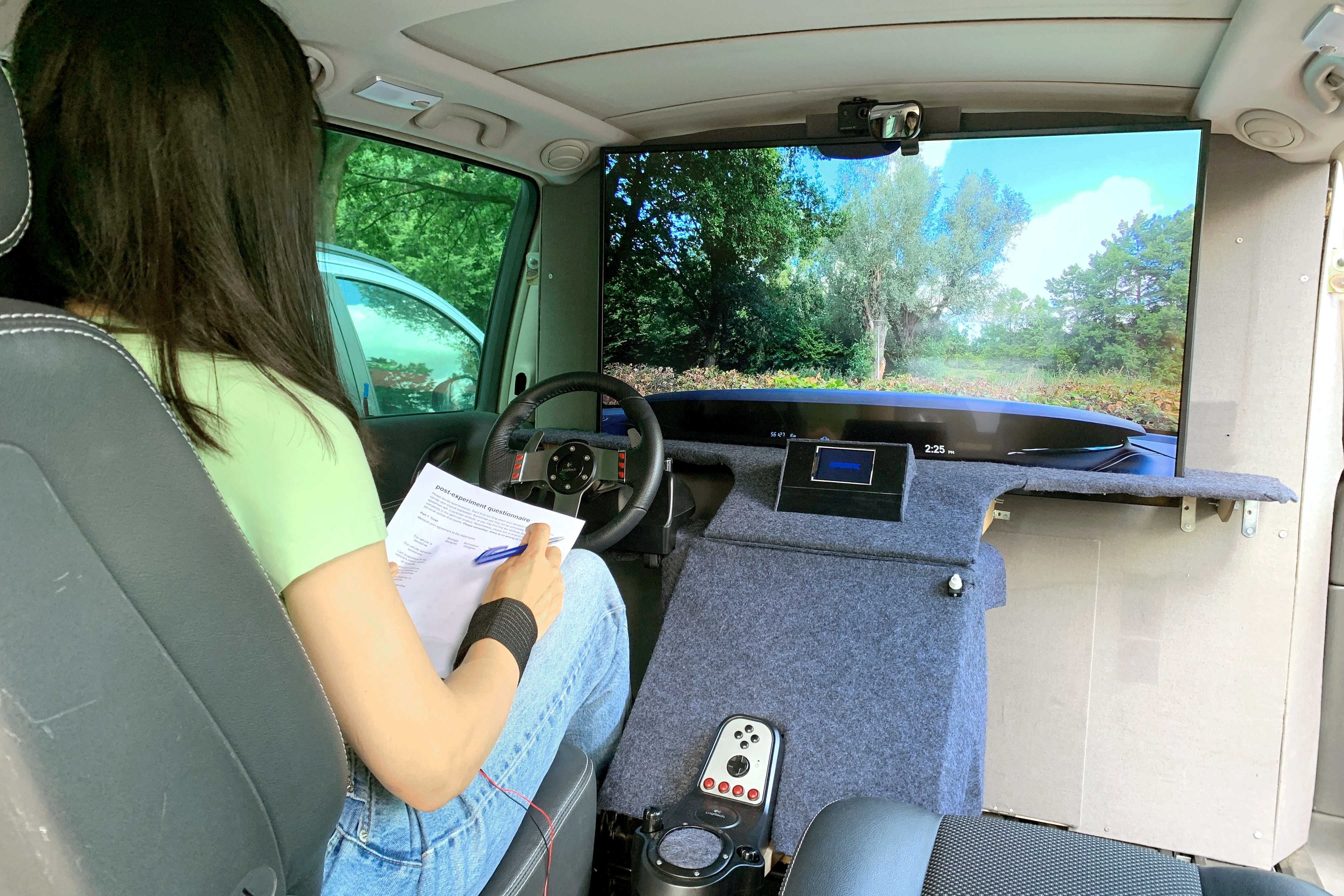
Future Automated Driving: How to Design to Mitigate Automation Surprise for Better User Experience?
Design Research Project
2021.11 - 2022.11
Skills: user study, qualitative research, interview, ideation, prototyping, experiment design.
Supervisors:Marieke Martens, Pavlo Bazilinskyy
Collaboration: Yuanzi Wang (Final Master Project)
This project is part of my PhD program,
check more about my PhD journey 🎓
Background
With the development of automated driving technology, let's envision in the near future that we are able to enjoy other activities in automated vehicles (AV). However, general public still have concerns about AV driving in everyday
traffic and recent research shows that acceptance of AV drops as the level of automation increases.
Consider a scenario in which the driver is check his phone in AV and his attention is diverted from the road. Conseqently, if the AV brakes suddenly due to a front car slowing down, the driver may be caught off guard and experiences
a negative surprise (automation surprise, AS). This causes discomfort and hindering the driver to enjoy his ride fully.
Research Goal
Through literature research and a concept-driven design process, we created a haptic-based anticipatory cue, that prompts the user to glance or scan around to acquire potential information in the real-world environment, therefore mitigating
AS. We proposed this design concept based on previous concepts and theoretical guidance of calm technology and peripheral interaction. As during automated driving, the information involved may not be safety-related or time-critical
and the interactions may afford to happen mostly in the periphery of the user's attention.
Our process involved creating hypothetical interaciton diagram, developing lo-fidelity prototype, established a Wizard of Oz environment to observe how people experience the prototype. Insights from research led to proposing
further ressearch agenda and desing iteration for high-fidelity prototypes.
Design Concept
waiting for publication
Modification of WoZ Vehicle
The Wizard-of-Oz (WoZ) vehicle used in this study possessed by the Department of Industrial Design, Eindhoven University of Technology. It is a modified Renault Espace 2.0 and was initially designed and used in the studies by Dr. Juffrizal Karjanto and Dr. Nidzamuddin Yusof during their Ph.D. project (2018), investigating motion sickness in fully automated vehicles (SAE Level 5).
The original setup of the WoZ vehicle does not provide the experimental setup of level 3 to level 5 AVs, as the main focus of this study. Therefore, we modified the interior by adding a fake dashboard, steering wheel and pedals.
WoZ Technique
The WoZ technique aims to provide approachable and physical experience of not-yet-existing technologies, in this case, the feeling of sitting in the driver's seat of an AV.. The human driver drives the WoZ vehicle (wizard driver) was seated in the normal driver's seat. The back row of seats was used for the participants. A partition (6) was installed to ensure the wizard driver is invisible to the participants. A TV screen (7) was mounted to the partition, which is connected to a camera (3) mounted on the windshield, which could capture the front view. When sitting in the back seat, the participants could view the frontal view of the car in real time through the TV screen.


Methodology: Research through Design
Throughout this study, we employed the research-through-design (RtD) approach due to its reflective nature, which allows for the continuous interpretation and framing of a given situation. This approach involves a process of making and critiquing artifacts that function as proposed solutions. By creating tangile artifacts and conducting on-road qualitative study employing a WoZ vehicle, I explore the non-critical automated driving experience and gain insight into the iteration of non-intrusive interaction design.
Experiment & Result
Waiting for publication
Ackowledgement
This experiment is huge, and we could never have managed it without all the help from friends and colleagues. I would like to express my gratitude to everybody:
- all the participants who took part in this experiment
- d.search lab (Industrial Design department) for their assistance in developing and modifying the Mobility Lab and for their contributions to the preparation and execution of the experiment
- Henk Apeldoorn for support in the development of the fake steering wheel
- the wizard drivers: Jasper Sterk, Mayra Goevaerts, Marlen Braun, and Pedro Oliveira
- Anika Boelhouwer's feedback on the video analysis
- Erwin Meinders for support with practical matters
- Debargha Dey, Mathias Funk, Ruolin Guo, Benno Thijs, Thomas Marinissen, Frank Delbressine, Eden Chiang, Juffrizal Karjanto, and Nidzamuddin Yusof for their support
